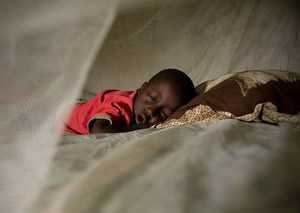Implementing Evidence-based Public Health Programs
CDC Kenya, in collaboration with local and international partners, evaluates, implements, and scales up proven approaches to achieve large-scale and demonstrable reductions in preventable illness and death.
Mothers and Newborns

For children under five in particular, like 3-year-old Fadhil Smith, bed nets provided by the CDC can literally mean the difference between life and death. CDC figures show that where once children were exposed to as many as 300 infected mosquito bites each year, the number today is closer to three. © David Synder
Our strong partnership with the Kenya Ministry of Health is critical to achieving maternal and newborn health goals. As a major implementer of the President’s Emergency Program for AIDS Relief (PEPFAR), CDC Kenya works to prevent mother-to-child transmission of HIV. CDC Kenya ensures that pregnant women receive routine HIV testing, that HIV-infected mothers and their exposed infants receive antiretroviral therapy, and that families receive education on safe infant feeding practices.
To contribute to the world's knowledge about how best to protect pregnant women from malaria, CDC Kenya conducts research on intermittent preventive treatment in pregnancy (IPTp). Within this research context, CDC Kenya has been able to provide participating mothers with health education, free transportation to deliver in a healthcare facility, and waived delivery costs, which has resulted in over 90% of the participants delivering at a health facility compared to an average of 40% in the same communities. CDC Kenya is partnering with the CDC Foundation to extend free transportation and supplies for safe delivery to pregnant women outside the IPTp study.
Infants and Children
In Kenya, more than 1 in 7 children die before their fifth birthday from causes that are largely preventable: pneumonia, diarrhea, and malaria, with malnutrition often as an underlying cause. One of the best investments we can make to fight preventable diseases and curb child deaths is to improve routine immunization, particularly for pneumonia and diarrhea. Since rotavirus is the most common cause of severe diarrhea in infants and children worldwide, CDC Kenya, in collaboration with the Kenya Medical Research Institute (KEMRI), was one of several sites for a rotavirus vaccine trial. Results of the trial showed the RotaTeqTM vaccine reduced the number of cases of severe rotavirus diarrhea by 82 percent in the first year of life. As a result, the World Health Organization (WHO) has recommended that rotavirus vaccination be included in all national immunization programs.
Since the introduction of a pneumococcal vaccine in the routine immunization schedule in Kenya in February of 2011, CDC and KEMRI have conducted a population-based, post-introduction vaccine safety surveillance study of PCV10 – the first preservative-free multi-dose vaccine being used in the a developing country - that will help inform WHO vaccine policy. Vaccinations against diarrheal diseases and pneumonia are starting to change the trends in deaths of children younger than five.
Families and Communities
CDC Kenya and partners work in refugee camps in the region to conduct surveillance for infectious diseases and provide support for disease outbreak and emergency response. Each year, up to 25,000 refugees from African countries are resettled in the United States. Before resettlement, most refugees have resided in difficult environments with limited access to medical care and preventive health services, leaving them at a significantly increased risk of illness, death and disability from a variety of health problems. CDC provides testing and treatment for several diseases before refugees emigrate and liaises with the Office of Refugee Resettlement and other partners to ensure a continuum of care is provided for refugees as they transition to life in the United States.
CDC Kenya’s longstanding malaria research activities have helped to inform the development and evaluation of key malaria prevention and treatment interventions used by global malaria programs today. In 2013, through the President’s Malaria Initiative (PMI), CDC Kenya has contributed to efforts to provide 6.5 million malaria rapid diagnostic tests and provide 4 million artemisinin-combination treatments for malaria. Many families were also protected from malaria through indoor residual spraying. This massive scale-up has helped reduce childhood death rates by as much as 50%.
In 2014, CDC Kenya, together with university, faith-based, and non-governmental partners, helped over 3 million Kenyans know their HIV status through voluntary, home-based, and provider-initiated HIV testing and counseling (HTC). Ensuring individuals and couples know their HIV status and, if HIV positive, enrolled in care and treatment programs significantly improves the health of individuals. Early treatment also reduces transmission to HIV-negative partners by 96 percent. In 2003, only 5,000 Kenyans were on treatment. Through the President’s Emergency Plan for AIDS Relief (PEPFAR), of which CDC is an implementing agency, over 740,000 people in Kenya, including 71,000 of children, are on antiretroviral therapy and leading longer, healthier lives.
- Page last reviewed: March 30, 2015
- Page last updated: March 30, 2015
- Content source:
Global Health
Notice: Linking to a non-federal site does not constitute an endorsement by HHS, CDC or any of its employees of the sponsors or the information and products presented on the site.


 ShareCompartir
ShareCompartir